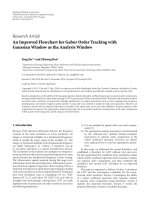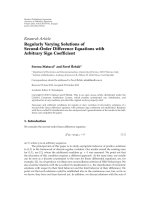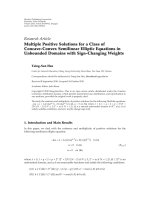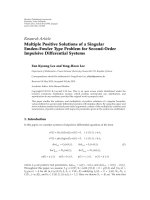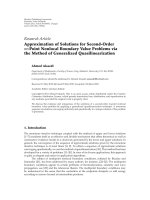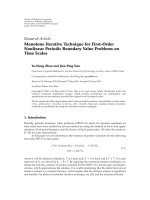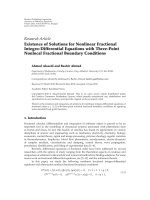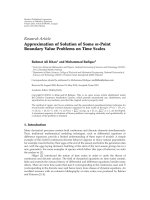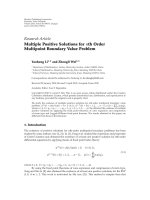Báo cáo sinh học: " Research Article Multiple Positive Solutions for nth Order Multipoint Boundary Value Problem" docx
Bạn đang xem bản rút gọn của tài liệu. Xem và tải ngay bản đầy đủ của tài liệu tại đây (503.85 KB, 13 trang )
Hindawi Publishing Corporation
Boundary Value Problems
Volume 2010, Article ID 708376, 13 pages
doi:10.1155/2010/708376
Research Article
Multiple Positive Solutions for nth Order
Multipoint Boundary Value Problem
Yaohong Li
1, 2
and Zhongli Wei
2, 3
1
Department of Mathematics, Suzhou University, Suzhou, Anhui 234000, China
2
School of Mathematics, Shandong University, Jinan, Shandong 250100, China
3
School of Sciences, Shandong Jianzhu University, Jinan, Shandong 250101, China
Correspondence should be addressed to Yaohong Li,
Received 22 January 2010; Revised 9 April 2010; Accepted 3 June 2010
Academic Editor: Ivan T. Kiguradze
Copyright q 2010 Y. Li and Z. Wei. This is an open access article distributed under the Creative
Commons Attribution License, which permits unrestricted use, distribution, and reproduction in
any medium, provided the original work is properly cited.
We study the existence of multiple positive solutions for nth-order multipoint boundary value
problem. u
n
tatfut 0, t ∈ 0, 1, u
j−1
00j 1, 2, ,n− 1, u1
m
i1
α
i
uη
i
,
where n ≥ 2, 0 <η
1
<η
2
< ···<η
m
< 1, α
i
> 0,i 1, 2, ,m. We obtained the existence of multiple
positive solutions by applying the fixed point theorems of cone expansion and compression
of norm type and Leggett-Williams fixed-point theorem. The results obtained in this paper are
different from those in the literature.
1. Introduction
The existence of positive solutions for nth-order multipoint boundary problems has been
studied by some authors see 1, 2 .In1, Pang et al. studied the expression and properties
of Green’s funtion and obtained the existence of at least one positive solution for nth-order
differential equations by applying means of fixed point index theory:
u
n
t
a
t
f
u
t
0,t∈
0, 1
,
u
j−1
0
0
j 1, 2, ,n− 1
,u
1
m
i1
α
i
u
η
i
,
1.1
where n ≥ 2, 0 <η
1
<η
2
< ···<η
m
< 1,α
i
> 0,i 1, 2, ,m.
By using the fixed point theorems of cone expansion and compression of norm type,
Yang and Wei in 2 also obtained the existence of at least one positive solutions for the BVP
1.1 if m ≥ 2. This work is motivated by Ma see 3. This method is simpler than that
2 Boundary Value Problems
of 1. In addition, Eloe and Ahmad in 4 had solved successfully the existence of positive
solutions to the BVP 1.1 if m 1. Hao et al. in 5 had discussed the existence of at least two
positive solutions for the BVP 1.1 by applying the Krasonse’skii-Guo fixed point theorem
on cone expansion and compression if m 1. However, there are few papers dealing with the
existence of multiple positive solutions for nth-order multipoint boundary value problem.
In this paper, we study the existence of at least two positive solutions associated with
the BVP 1.1 by applying the fixed point theorems of cone expansion and compression of
norm type if m ≥ 2 and the existence of at least three positive solutions for BVP 1.1 by using
Leggett-Williams fixed-point theorem. The results obtained in this paper are different from
those in the literature and essentially improve and generalize some well-known results see
1–8.
The rest of the paper is organized as follows. In Section 2, we present several lemmas.
In Section 3, we give some preliminaries and the fixed point theorems of cone expansion and
compression of norm type. The existence of at least two positive solutions for the BVP 1.1
is formulated and proved in Section 4.InSection 5, we give Leggett-Williams fixed-point
theorem and obtain the existence of at least three positive solutions for the BVP 1.1.
2. Several Lemmas
Definition 2.1. A function ut is said to be a position of the BVP 1.1 if ut satisfies the
following:
1 ut ∈ C0, 1 ∩ C
n
0, 1;
2 ut > 0fort ∈ 0, 1 and satisfies boundary value conditions 1.1;
3 u
n
t−atfut hold for t ∈ 0, 1.
Lemma 2.2 see 1. Suppose that
D
m
i1
α
i
η
n−1
i
/
1;
2.1
then for any y ∈ C0, 1, the problem
u
n
t
y
t
0,t∈
0, 1
,
u
j−1
0
0
j 1, 2, ,n− 1
,u
1
m
i1
α
i
u
η
i
2.2
has a unique solution:
u
t
−
1
n − 1
!
t
0
t − s
n−1
y
s
ds
t
n−1
n − 1
!
1 − D
1
0
1 − s
n−1
y
s
ds
−
t
n−1
n − 1
!
1 − D
m−2
i1
α
i
η
i
0
η
i
− s
n−1
y
s
ds
1
0
K
t, s
y
s
ds,
2.3
Boundary Value Problems 3
where
K
t, s
K
1
t, s
K
2
t, s
,
K
1
t, s
1
n − 1
!
⎧
⎨
⎩
t
n−1
1 − s
n−1
−
t − s
n−1
, 0 ≤ s<t≤ 1,
t
n−1
1 − s
n−1
, 0 ≤ t ≤ s ≤ 1,
K
2
t, s
D
n − 1
!
1 − D
t
n−1
1 − s
n−1
−
1
n − 1
!
1 − D
s≤η
i
α
i
t
n−1
η
i
− s
n−1
.
2.4
Lemma 2.3 see 1. Let D<1; Green’s function Kt, s defined by 2.4 satisfies
0 ≤ K
t, s
≤ K
s
, ∀t, s ∈
0, 1
,
min
t∈η
1
,1
K
t, s
≥ γK
s
, ∀s ∈
0, 1
,
2.5
where γ η
n−1
1
:
K
s
max
t∈0,1
K
1
t, s
max
t∈0,1
K
2
t, s
s
n−1
1 − s
n−1
n − 1
!
1 −
1 − s
n−1/n−2
2−n
K
2
1,s
.
2.6
We omit the proof Lemma 2.3 here and you can see the detail of Theorem 2.2in1.
Lemma 2.4 see 2. Let D<1,y∈ C0, 1, and y ≥ 0; the unique solution ut of the BVP 2.2
satisfies
min
t∈η
1
,1
u
t
≥ γ
u
,
2.7
where γ is defined by Lemma 2.3, u max
t∈0,1
|ut|.
3. Preliminaries
In this section, we give some preliminaries for discussing the existence of multiple positive
solutions of the BVP 1.1 in the next. In real Banach space C0, 1 in which the norm is defined
by
u
max
t∈0,1
|
u
t
|
,
3.1
set
P
u ∈ C
0, 1
| u
0
0,u
t
> 0for0<t≤ 1, min
t∈
η
1
,1
u
t
≥ γ
u
.
3.2
Obviously, P is a positive cone in C0, 1, where γ is from Lemma 2.3.
4 Boundary Value Problems
For convenience, we make the following assumptions:
A
1
a : 0, 1 → 0, ∞ is continuous and at does not vanish identically, for t ∈
η
1
, 1;
A
2
f : 0, ∞ → 0, ∞ is continuous;
A
3
D
m
i1
α
i
η
n−1
i
< 1.
Let
Au
t
1
0
K
t, s
a
s
f
u
s
ds, ∀t ∈
0, 1
,
3.3
where Kt, s is defined by 2.4.
From Lemmas 2.2–2.4, we have the following result.
Lemma 3.1 see 2. Suppose that A
1
–A
3
are satisfied, then A : C0, 1 → C0, 1 is a
completely continuous operator, AP ⊂ P, and the fixed points of the operator A in P are the positive
solutions of the BVP 1.1.
For convenience, one introduces the following notations. Let
r
1
n − 1
!
1 − D
1
0
1 − s
n−1
a
s
ds,
R
γ
m
i2
α
i
n − 1
!
1 − D
η
i
η
1
η
i
− η
i
s
n−1
−
η
i
− s
n−1
a
s
ds
m ≥ 2
.
3.4
Problem 1. Inspired by the work of the paper 2, whether we can obtain a similar conclusion
or not, if
lim
u → 0
inf
f
u
u
>R
−1
, lim
u → ∞
inf
f
u
u
>R
−1
;
3.5
or
lim
u → 0
sup
f
u
u
<r
−1
, lim
u → ∞
sup
f
u
u
<r
−1
. 3.6
The aim of the following section is to establish some simple criteria for the existence of
multiple positive solutions of the BVP 1.1, which gives a positive answer to the questions
stated above. The key tool in our approach is the following fixed point theorem, which is
a useful method to prove the existence of positive solutions for differential equations, for
example 2–5, 9.
Lemma 3.2 see 10, 11. Suppose that E is a real Banach space and P is cone in E, and let Ω
1
, Ω
2
be two bounded open sets in E such that 0 ∈ Ω
1
, Ω
1
⊂ Ω
2
. Let operator A : P ∩ Ω
2
\ Ω
1
→ P be
completely continuous. Suppose that one of two conditions holds:
i Au≤u, for all u ∈ P ∩ ∂Ω
1
; Au≥u, for all u ∈ P ∩ ∂Ω
2
;
ii Au≥u, for all u ∈ P ∩ ∂Ω
1
; Au≤u, for all u ∈ P ∩ ∂Ω
2
.
then A has at least one fixed point in P ∩
Ω
2
\ Ω
1
.
Boundary Value Problems 5
4. The Existence of Two Positive Solutions
Theorem 4.1. Suppose that the conditions A
1
–A
3
are satisfied and the following assumptions
hold:
B
1
lim
u → 0
inffu/u >R
−1
;
B
2
lim
u → ∞
inffu/u >R
−1
;
B
3
There exists a constant ρ>0 such that fu ≤ r
−1
ρ, u ∈ 0,ρ.
Then the BVP 1.1 has at least two positive solutions u
1
and u
2
such that
0 <
u
1
<ρ<
u
2
. 4.1
Proof. At first, it follows from the condition B
1
that we may choose ρ
1
∈ 0,ρ such that
f
u
>R
−1
u, 0 <u≤ ρ
1
.
4.2
Set Ω
1
{u ∈ C0, 1 : u <ρ
1
},andu ∈ P ∩ ∂Ω
1
;from3.3 and 2.4 and Lemma 2.4,for
0 <t≤ 1, we have
Au
1
1
n − 1
!
1 − D
1
0
D
1 − s
n−1
a
s
f
u
s
ds −
m−2
i1
α
i
η
i
0
η
i
− s
n−1
a
s
f
u
s
ds
≥
m
i1
α
i
n − 1
!
1 − D
η
i
0
η
i
− η
i
s
n−1
−
η
i
− s
n−1
a
s
f
u
s
ds
>
R
−1
m
i1
α
i
n − 1
!
1 − D
η
i
0
η
i
− η
i
s
n−1
−
η
i
− s
n−1
a
s
u
s
ds
>
R
−1
m
i2
α
i
n − 1
!
1 − D
η
i
η
1
η
i
− η
i
s
n−1
−
η
i
− s
n−1
a
s
u
s
ds
>
R
−1
γ
u
m
i2
α
i
n − 1
!
1 − D
η
i
η
1
η
i
− η
i
s
n−1
−
η
i
− s
n−1
a
s
ds
R
−1
R
u
u
.
4.3
Therefore, we have
Au
≥
Au
1
>
u
,u∈ P ∩ ∂Ω
1
. 4.4
Further, it follows from the condition B
2
that there exists ρ
2
>ρsuch that
f
u
>R
−1
u, u ≥ ρ
2
.
4.5
6 Boundary Value Problems
Let ρ
∗
max{2ρ, γ
−1
ρ
2
},setΩ
2
{u ∈ C0, 1 : u <ρ
∗
}, then u ∈ P ∩ ∂Ω
2
and Lemma 2.4
imply
min
η
1
≤t≤1
u
t
≥ γ
u
≥ ρ
2
,
4.6
and by the condition B
2
, 2.4, 3.3,andLemma 2.4, we have
Au
1
1
n − 1
!
1 − D
1
0
D
1 − s
n−1
a
s
f
u
s
ds −
m
i1
α
i
η
i
0
η
i
− s
n−1
a
s
f
u
s
ds
≥
m
i1
α
i
n − 1
!
1 − D
η
i
0
η
i
− η
i
s
n−1
−
η
i
− s
n−1
a
s
f
u
s
ds
>
R
−1
m
i1
α
i
n − 1
!
1 − D
η
i
0
η
i
− η
i
s
n−1
−
η
i
− s
n−1
a
s
u
s
ds
>
R
−1
m
i2
α
i
n − 1
!
1 − D
η
i
η
1
η
i
− η
i
s
n−1
−
η
i
− s
n−1
a
s
u
s
ds
>
R
−1
γ
u
m−2
i2
α
i
n − 1
!
1 − D
η
i
η
1
η
i
− η
i
s
n−1
−
η
i
− s
n−1
a
s
ds
R
−1
R
u
u
.
4.7
Therefore, we have
Au
≥
Au
1
>
u
,u∈ P ∩ ∂Ω
2
. 4.8
Finally, let Ω
3
{u ∈ C0, 1 : u <ρ} and u ∈ P ∩ ∂Ω
3
.By2.3, 3.3, and the condition
B
3
, we have
Au
t
≤
t
n−1
n − 1
!
1 − D
1
0
1 − s
n−1
a
s
f
u
s
ds
≤
r
−1
ρ
n − 1
!
1 − D
1
0
1 − s
n−1
a
s
ds r
−1
rρ
u
,
4.9
which implies
Au
≤
u
,u∈ P ∩ ∂Ω
3
. 4.10
Thus from 4.4–4.10 and Lemmas 3.1 and 3.2, A has a fixed point u
1
in P ∩ Ω
3
\ Ω
1
and a
fixed u
2
in P ∩ Ω
2
\ Ω
3
. Both are positive solutions of BVP 1.1 and satisfy
0 <
u
1
<ρ<
u
2
. 4.11
The proof is complete.
Boundary Value Problems 7
Corollary 4.2. Suppose that the conditions A
1
–A
3
are satisfied and the following assumptions
hold:
B
1
lim
u → 0
inffu/u∞;
B
2
lim
u → ∞
inffu/u∞;
B
3
there exists a constant ρ
> 0 such that fu ≤ r
−1
ρ
,u∈ 0,ρ
.
Then the BVP 1.1 has at least two positive solutions u
1
and u
2
such that
0 <
u
1
<ρ
<
u
2
. 4.12
Proof. From the conditions B
i
i 1, 2, there exist sufficiently big positive constants M
i
i
1, 2 such that
lim
u → 0
sup
f
u
u
>M
2
, lim
u → ∞
sup
f
u
u
>M
1
4.13
by the condition B
3
; so all the conditions of Theorem 4.1 are satisfied; by an application of
Theorem 4.1,theBVP1.1 has two positive solutions u
1
and u
2
such that
0 <
u
1
<ρ
<
u
2
. 4.14
Theorem 4.3. Suppose that the conditions A
1
–A
3
are satisfied and the following assumptions
hold:
C
1
lim
u → 0
supfu/u <r
−1
;
C
2
lim
u → ∞
supfu/u <r
−1
;
C
3
there exists a constant l>0 such that fu ≥ R
−1
l, u ∈ γl,l.
Then the BVP 1.1 has at least two positive solutions u
1
and u
2
such that
0 <
u
1
<l<
u
2
. 4.15
Proof. It follows from the condition C
1
that we may choose ρ
3
∈ 0,l such that
f
u
<r
−1
u, 0 <u≤ ρ
3
.
4.16
Set Ω
4
{u ∈ C0, 1 : u <ρ
3
}, and u ∈ P ∩ ∂Ω
4
;from3.2 and 2.4,for0<t≤ 1, we have
Au
t
≤
t
n−1
n − 1
!
1 − D
1
0
1 − s
n−1
a
s
f
u
s
ds
<
r
−1
u
n − 1
!
1 − D
1
0
1 − s
n−1
a
s
ds r
−1
r
u
u
.
4.17
8 Boundary Value Problems
Therefore, we have
Au
<
u
,u∈ P ∩ ∂Ω
4
. 4.18
It follows from the condition C
2
that there exists ρ
4
>lsuch that fu <r
−1
u for u ≥ ρ
4
, and
we consider two cases.
Case i. Suppose that f is unbounded; there exists l
∗
>ρ
4
such that fu ≤ fl
∗
for 0 <u≤ l
∗
.
Then for u ∈ P and u l
∗
, we have
Au
t
≤
t
n−1
n − 1
!
1 − D
1
0
1 − s
n−1
a
s
f
u
s
ds
≤
t
n−1
n − 1
!
1 − D
1
0
1 − s
n−1
a
s
f
l
∗
ds
<
r
−1
l
∗
n − 1
!
1 − D
1
0
1 − s
n−1
a
s
ds r
−1
rl
∗
l
∗
u
.
4.19
Case ii. If f is bounded, that is, fu ≤ N for all u ∈ 0, ∞, taking l
∗
≥ max{2l, Nr},for
u ∈ P and u l
∗
, we have
Au
t
≤
t
n−1
n − 1
!
1 − D
1
0
1 − s
n−1
a
s
f
u
s
ds
≤
N
n − 1
!
1 − D
1
0
1 − s
n−1
a
s
ds ≤ Nr ≤ l
∗
u
.
4.20
Hence, in either case, we always may set Ω
5
{u ∈ C0, 1 : u <l
∗
} such that
Au
≤
u
,u∈ P ∩ ∂Ω
5
. 4.21
Finally, set Ω
6
{u ∈ C0, 1 : u <l}; then u ∈ P ∩ ∂Ω
6
and Lemma 2.4 imply
min
t∈η
1
,1
u
t
≥ γ
u
γl,
4.22
Boundary Value Problems 9
and by the condition C
3
, 2.4,and3.3, we have
Au
1
1
n − 1
!
1 − D
1
0
D
1 − s
n−1
a
s
f
u
s
ds −
m
i1
α
i
η
i
0
η
i
− s
n−1
a
s
f
u
s
ds
≥
m
i1
α
i
n − 1
!
1 − D
η
i
0
η
i
− η
i
s
n−1
−
η
i
− s
n−1
a
s
f
u
s
ds
≥
R
−1
l
m
i2
α
i
n − 1
!
1 − D
η
i
η
1
η
i
− η
i
s
n−1
−
η
i
− s
n−1
a
s
ds
≥
R
−1
lγ
m
i2
α
i
n − 1
!
1 − D
η
i
η
1
η
i
− η
i
s
n−1
−
η
i
− s
n−1
a
s
ds
R
−1
lR
u
.
4.23
Hence, we have
Au
≥
u
,u∈ P ∩ ∂Ω
6
. 4.24
From 4.18–4.24 and Lemmas 3.1 and 3.2, A has a fixed point u
1
in P ∩ Ω
6
\Ω
4
and a fixed
u
2
in P ∩ Ω
5
\ Ω
6
. Both are positive solutions of the BVP1.1 and satisfy
0 <
u
1
<l<
u
2
. 4.25
The proof is complete.
Corollary 4.4. Suppose that the conditions A
1
–A
3
are satisfied and the following assumptions
hold:
C
1
lim
u → 0
supfu/u0;
C
2
lim
u → ∞
supfu/u0;
C
3
there exists a constant ρ
> 0 such that fu ≥ R
−1
ρ
,u∈ γρ
,ρ
.
Then BVP 1.1 has at least two positive solutions u
1
and u
2
such that
0 <
u
1
<ρ
<
u
2
. 4.26
The proof of Corollary 4.4 is similar to that of Corollary 4.2; so we omit it.
10 Boundary Value Problems
5. The Existence of Three Positive Solutions
Let E be a real Banach space with cone P . A map β : P → 0, ∞ is said to be a nonnegative
continuous concave functional on P if β is continuous and
β
tx
1 − t
y
≥ tβ
x
1 − t
β
y
5.1
for all x, y ∈ P and t ∈ 0, 1. Let a, b be two numbers such that 0 <a<band let β be a
nonnegative continuous concave functional on P . We define the following convex sets:
P
a
{
x ∈ P :
x
<a
}
,∂P
a
{
x ∈ P :
x
a
}
, P
a
{
x ∈ P :
x
≤ a
}
,
P
β, a, b
x ∈ P : a ≤ β
x
,
x
≤ b
.
5.2
Lemma 5.1 see 12. Let A :
P
c
→ P
c
be completely continuous and let β be a nonnegative
continuous concave functional on P such that βx ≤x for x ∈
P
c
. Suppose that there exist
0 <d<a<b≤ c such that
i {x ∈ Pβ, a, b : βx >a}
/
∅ and βAx >afor x ∈ Pβ, a, b,
ii Ax <dfor x≤d,
iii βAx >afor x ∈ Pβ,a, c with Ax >b.
Then A has at least three fixed points x
1
,x
2
,x
3
in P
c
such that
x
1
<d,a<β
x
2
, and
x
3
>d with β
x
3
<a. 5.3
Now, we establish the existence conditions of three positive solutions for the BVP 1.1.
Theorem 5.2. Suppose that A
1
–A
3
hold and there exist numbers a and d with 0 <d<asuch
that the following conditions are s atisfied:
D
1
lim
u →∞
fu/u < 1/G,
D
2
fu <d/G, u∈ 0,d,
D
3
fu >a/F, u∈ a, a/γ,
where
F min
t∈
η
1
,1
1
η
1
K
t, s
a
s
ds, G max
t∈0,1
1
0
K
t, s
a
s
ds,
5.4
Then the boundary value problem 1.1 has at least three positive solutions.
Proof. Let P be defined by 3.2 and let A be defined by 3.3. For u ∈ P,let
β
u
min
t∈η
1
,1
u
t
.
5.5
Boundary Value Problems 11
Then it is easy to check that β is a nonnegative continuous concave functional on P with
βu ≤u for u ∈ P and A : P → P is completely continuous.
First, we prove that if D
1
holds, then there exists a number c>a/γand A : P
c
→ P
c
.
To do this, by D
1
, there exist M>0andλ<1/G such that
f
u
< λu, for u>M. 5.6
Set
δ max
u∈
0,M
f
u
;
5.7
it follows that fu <λu δ for all u ∈ 0, ∞. Take
c>max
δG
1 − λG
,
a
γ
.
5.8
If u ∈
P
c
, then
Au
t
≤ max
t∈
0,1
1
0
K
t, s
a
s
f
u
s
ds < max
t∈0,1
1
0
K
t, s
a
s
ds
λ
u
δ
<
λc δ
G<c,
5.9
that is,
Au
<c. 5.10
Hence 5.10 show that if D
1
holds, then there exists a number c>a/γsuch that A maps
P
c
into P
c
.
Now we show that {u ∈ Pβ, a, a/γ : βu >a}
/
∅ and βAu >afor all u ∈
Pβ, a, a/γ. In fact, take xt ≡ a a/γ/2 >a,sox ∈{u ∈ Pβ, a, a/γ : βu >a}.
Moreover, for u ∈ Pβ, a, a/γ, then βu >a, and we have
a
γ
≥
u
≥ β
u
>a.
5.11
Therfore, by D
3
we obtain
β
Au
min
t∈
η
1
,1
1
0
K
t, s
a
s
f
u
s
ds >
a
F
min
t∈η
1
,1
1
η
1
K
t, s
a
s
ds a.
5.12
Next, we assert that Au <dfor u≤d. In fact, if u ∈
P
d
,byD
2
we have
Au
<
d
G
max
t∈
0,1
1
0
K
t, s
a
s
ds
d. 5.13
Hence, A :
P
d
→ P
d
for u ∈ P
d
.
12 Boundary Value Problems
Finally, we assert that if u ∈ Pβ, a, c and Au >a/γ, t hen βAu >a.Toseethis,if
u ∈ P β, a, c and Au >a/γ,then we have from Lemma 2.3 that
β
Au
min
t∈η
1
,1
1
0
K
t, s
a
s
f
u
s
ds
≥
1
0
min
t∈
η
1
,1
K
t, s
a
s
f
u
s
ds ≥ γ
1
0
K
s
a
s
f
u
s
ds
≥ γ
1
0
max
t∈
0,1
K
t, s
a
s
f
u
s
ds ≥ γ max
t∈0,1
1
0
K
t, s
a
s
f
u
s
ds γ
Au
.
5.14
So we have
β
Au
≥ γ
Au
>γ·
a
γ
a.
5.15
To sum up 5.10∼5.15, all the conditions of Lemma 5.1 are satisfied by taking b a/γ.
Hence, A has at least three fixed points; that is, BVP 1.1 has at least three positive solutions
u
1
,u
2
,andu
3
such that
u
1
<d,a<β
u
2
, and
u
3
>d with β
u
3
<a. 5.16
The proof is complete.
Acknowledgments
The authors are grateful to the referee’s valuable comments and suggestions. The project is
supported by the Natural Science Foundation of Anhui Province KJ2010B226, The Excellent
Youth Foundation of Anhui Province Office of Education 2009SQRZ169, and the Natural
Science Foundation of Suzhou University 2009yzk17
References
1 C. Pang, W. Dong, and Z. Wei, “Green’s function and positive solutions of nth order m-point
boundary value problem,” Applied Mathematics and Computation, vol. 182, no. 2, pp. 1231–1239, 2006.
2 J. Yang and Z. Wei, “Positive solutions of nth order m-point boundary value problem,” Applied
Mathematics and Computation, vol. 202, no. 2, pp. 715–720, 2008.
3 R. Ma, “Positive solutions of a nonlinear three-point boundary-value problem,” Electronic Journal of
Differential Equations, vol. 1999, no. 34, pp. 1–8, 1999.
4 P. W. Eloe and B. Ahmad, “Positive solutions of a nonlinear nth order boundary value problem with
nonlocal conditions,” Applied Mathematics Letters, vol. 18, no. 5, pp. 521–527, 2005.
5 X. Hao, L. Liu, and Y. Wu, “Positive solutions for nonlinear nth-order singular nonlocal boundary
value problems,” Boundary Value Problems, vol. 2007, Article ID 74517, 10 pages, 2007.
6 R. Ma, “Existence of positive solutions for second order m-point boundary value problems,” Annales
Polonici Mathematici, vol. 79, no. 3, pp. 265–276, 2002.
7 R. Ma and N. Castaneda, “Existence of solutions of nonlinear m-point boundary-value problems,”
Journal of Mathematical Analysis and Applications, vol. 256, no. 2, pp. 556–567, 2001.
Boundary Value Problems 13
8 R. Ma, “Multiplicity of positive solutions for second-order three-point boundary value problems,”
Computers & Mathematics with Applications, vol. 40, no. 2-3, pp. 193–204, 2000.
9 B. Liu, “Positive solutions of fourth-order two point boundary value problems,” Applied Mathematics
and Computation, vol. 148, no. 2, pp. 407–420, 2004.
10 D. Guo, Nonlinear Functional Analysis, Shandong Science and Technology Press, Jinan, China, 2004.
11 D. Guo and V. Lakshmikantham, Nonlinear Problems in Abstract Cones, vol. 5 of Notes and Reports in
Mathematics in Science and Engineering, Academic Press, Boston, Mass, USA, 1988.
12 R. W. Leggett and L. R. Williams, “Multiple positive fixed points of nonlinear operators on ordered
Banach spaces,” Indiana University Mathematics Journal, vol. 28, no. 4, pp. 673–688, 1979.
